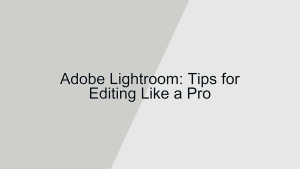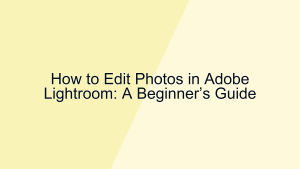Choosing the best photo editing software is crucial for photographers who want to maximize their creative potential and streamline their workflows. Adobe Lightroom and Capture One are two of the most popular options available, each offering powerful tools and unique features. This article will compare Adobe Lightroom and Capture One across several key aspects to help you determine which software best suits your photography needs.
1. User Interface and Experience
A smooth and intuitive user interface (UI) is essential for any photo editing software, as it impacts the overall ease of use and efficiency of the editing process.
- Adobe Lightroom’s User Interface: Adobe Lightroom is known for its clean, user-friendly interface that caters to both beginners and professionals. The workspace is divided into modules such as Library, Develop, and Map, each focusing on different aspects of the workflow. For example, a photographer can use the Library module to organize and sort their photos, while the Develop module is dedicated to detailed editing and adjustments. The interface is highly customizable, allowing users to arrange panels and tools according to their preferences. This streamlined and intuitive design makes Adobe Lightroom accessible to new users while providing the depth needed for advanced editing.
- Capture One’s User Interface: Capture One features a more complex and customizable interface, which may appeal to professional photographers with specific workflow requirements. The workspace is divided into customizable tabs, known as Tool Tabs, each containing a set of tools for different editing tasks. For instance, a user can create a custom Tool Tab for color grading, including all the necessary tools in one place. This level of customization allows photographers to tailor the interface to their precise needs, potentially speeding up their workflow. However, the complexity of Capture One’s interface might present a steeper learning curve for beginners. The highly customizable and professional-grade interface makes Capture One a robust choice for experienced photographers seeking a tailored editing environment.
2. Organization and Asset Management
Efficient organization and asset management are vital for photographers who handle large volumes of images. Both Adobe Lightroom and Capture One offer robust tools for managing photo libraries, but they take different approaches.
- Adobe Lightroom’s Organization: Adobe Lightroom excels in image organization, offering a comprehensive set of tools for managing photo libraries. Users can create and manage catalogs, collections, and smart collections to organize their images logically. For example, a wedding photographer might create separate collections for each event, making it easy to locate specific photos. Lightroom also offers robust metadata and keywording features, allowing users to tag and search for images efficiently. Additionally, the Library module provides options for rating, flagging, and color-coding images, further enhancing the organization. These powerful organization tools make Adobe Lightroom ideal for photographers who need to manage large and complex photo libraries.
- Capture One’s Organization: Capture One offers a flexible approach to image organization, with options for sessions and catalogs. Sessions are ideal for specific projects or shoots, allowing users to keep all related files and edits in one place. For instance, a fashion photographer might use sessions to manage images from a single photoshoot. Catalogs, on the other hand, are better suited for managing extensive photo libraries, similar to Lightroom’s catalogs. Capture One also provides robust metadata and keywording features, along with options for rating, flagging, and color-coding images. The flexibility of sessions and catalogs makes Capture One a versatile choice for photographers who require different organizational methods for various projects.
3. Editing Tools and Capabilities
The core of any photo editing software lies in its editing tools and capabilities. Both Adobe Lightroom and Capture One offer powerful editing features, but they have distinct strengths.
- Adobe Lightroom’s Editing Tools: Adobe Lightroom provides a comprehensive set of editing tools that cater to both basic and advanced adjustments. The Develop module includes tools for exposure, contrast, highlights, shadows, and color adjustments, among others. For example, a landscape photographer might use the Graduated Filter and Adjustment Brush to enhance specific areas of an image. Lightroom also offers advanced features such as HDR merging, panorama stitching, and lens corrections. Additionally, the non-destructive editing workflow ensures that original images remain untouched, allowing users to experiment freely. These versatile and powerful editing tools make Adobe Lightroom a go-to choice for photographers seeking a wide range of editing capabilities.
- Capture One’s Editing Tools: Capture One is renowned for its superior color grading and tethering capabilities, making it a favorite among professional photographers. The software offers advanced color editing tools, such as the Color Editor and Color Balance tools, enabling precise control over hues, saturation, and luminance. For instance, a portrait photographer might use the Color Editor to fine-tune skin tones. Capture One also excels in tethered shooting, providing a seamless connection between the camera and computer, ideal for studio work. The software’s layer-based editing system allows for non-destructive adjustments, offering greater flexibility in the editing process. These advanced editing tools and capabilities make Capture One an excellent choice for photographers who demand professional-grade color control and tethering options.
4. Performance and Speed
Performance and speed are critical for photographers who need to process large volumes of images efficiently. Let’s compare the performance aspects of Adobe Lightroom and Capture One.
- Adobe Lightroom’s Performance: Adobe Lightroom has made significant improvements in performance over recent years, enhancing speed and efficiency. The software utilizes GPU acceleration to improve the performance of certain tasks, such as image rendering and brush adjustments. For example, a photographer editing high-resolution images might notice faster response times when applying adjustments. However, Lightroom can still experience slowdowns when working with very large catalogs or performing intensive tasks. The software’s performance is generally satisfactory for most users, but those dealing with extensive photo libraries might require more robust hardware to achieve optimal speed. Overall, Adobe Lightroom offers good performance, but its efficiency depends on the complexity of the tasks and the hardware used.
- Capture One’s Performance: Capture One is known for its robust performance and speed, especially when handling large volumes of high-resolution images. The software utilizes advanced processing algorithms and GPU acceleration to ensure smooth and efficient editing. For instance, a commercial photographer working with medium format files might experience faster image rendering and adjustments in Capture One. The software’s efficient handling of tethered shooting sessions also contributes to its performance, providing a seamless experience during studio shoots. Capture One’s superior performance makes it a reliable choice for professional photographers who require fast and efficient processing of large image files.
5. Pricing and Subscription Models
The cost and flexibility of subscription models are important factors when choosing photo editing software. Let’s compare the pricing models of Adobe Lightroom and Capture One.
- Adobe Lightroom’s Pricing: Adobe Lightroom is available through a subscription-based model, with various plans to suit different needs. The Photography Plan, which includes Lightroom, Lightroom Classic, and Photoshop, is priced at $9.99 per month. For example, a photographer who needs both editing and graphic design capabilities might find this bundle cost-effective. Adobe also offers a Lightroom-only plan at $9.99 per month, suitable for users who exclusively need photo editing tools. The subscription model ensures that users always have access to the latest updates and features. However, some photographers might prefer a one-time purchase option instead of a recurring subscription. The subscription-based pricing model makes Adobe Lightroom accessible, but it might not appeal to those who prefer to avoid ongoing costs.
- Capture One’s Pricing: Capture One offers both subscription and perpetual license options, providing flexibility for different user preferences. The subscription plans start at $20 per month for the Pro version, which includes all features and tools. For instance, a professional photographer might opt for the subscription plan to always have access to the latest updates. Capture One also offers a perpetual license option, starting at $299, allowing users to make a one-time purchase and own the software indefinitely. Additionally, the software provides tailored versions for specific camera brands at a lower cost. This flexible pricing model makes Capture One accessible to a wide range of users, accommodating both those who prefer subscriptions and those who favor one-time purchases.
Conclusion
Choosing between Adobe Lightroom and Capture One ultimately depends on your specific needs and preferences as a photographer. Adobe Lightroom excels in user-friendliness, organization, and versatile editing tools, making it ideal for photographers who prioritize ease of use and a comprehensive editing suite. On the other hand, Capture One stands out with its advanced color grading, tethering capabilities, and robust performance, catering to professional photographers who demand precise control and efficiency.
Consider your editing requirements, workflow preferences, and budget when making your decision. Both Adobe Lightroom and Capture One offer powerful tools and unique features, ensuring you can achieve your creative vision and enhance your photography workflow.












